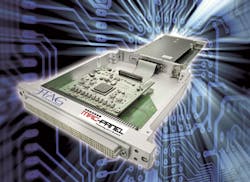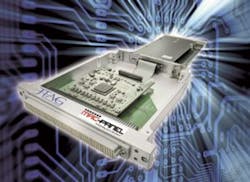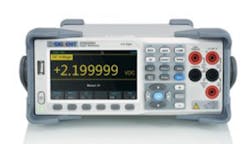Building upon the vendor’s capabilities in the design and supply of remote radio units for 4G mobile networks, the Millimetre-Wave 5G test system extends the features of the existing 4G modular test system. The new modules offer a compact, flexible solution for the emulation and aggregation of very wideband 5G radio channels at millimeter-wave frequencies. The modular design means that it is fully configurable to meet current and future standards and frequency bands.
The compact, rack-based Millimetre-Wave 5G test system comprises five individual 1U modules and is expandable to scale for additional capacity and frequency bands. The units supplied as standard include two Ultra-400+ radio modules, a +10-dBm 400-MHz to 6-GHz wideband output module, a 2×8:1 combiner module, and a 28-GHz millimetric converter module with an output bandwidth of greater than 1 GHz. The wide bandwidths of both the radio modules and the mmWave converter mean that up to eight 100-MHz carriers can be aggregated into a single 800-MHz carrier.
Initially being launched with an operating frequency in the 28-GHz band, modules also can be supplied for the planned 39-GHz and 60-GHz bands and for any other potential 5G mmWave bands, including 78 GHz, when required. AceAxis
The JT 2147/eDAK is a multifunction signal-conditioning module that allows “ideal world” connections from the vendor’s PXI and PXIe DataBlasters to the MAC Panel SCOUT connection system. Based on the vendor’s QuadPod architecture, the JT 2147/eDAK is an enhancement of the current DAK interface and has been specifically designed for robust high-integrity ATE systems. In using the JT 2147/eDAK, test system builders can simplify their wiring task and, at the same time, retain the signal integrity assured by the QuadPod’s active interface.
In addition to four independent JTAG test access ports (TAPs), the JT2147/eDAK features 64 digital I/O scan channels plus 16 static DIOs. Each TAP can be programmed to operate through a range of voltage levels, and two also can operate as other test and programming interfaces such as BDM or SWD.
eDAK adapters utilize standard MAC Panel connector modules, providing a variety of contact types. The connection between the PXI instrument and the receiver module is accomplished using either a passive printed circuit board, an active signal condition module (as with the JT 2147/eDAK), or a flex circuit, with each providing optimum connectivity performance while reducing wiring cost. JTAG Technologies
PXIe digital I/O modules
The EMX-75XX Series PXI Express (PXIe) digital input/output (I/O) modules are the latest addition to the vendor’s Core automated test equipment (Core ATE) PXIe functional test solutions. The EMX-75XX Series is a family of high-performance PXIe modules that support multiple I/O configurations and logic levels. Dedicated input or output modules are available for fixed high-channel-count applications. Other units provide flexibility with eight 8-bit ports (64 channels) that can be configured as either input or output under programmatic control.
Modules are available with internal pull-up resistors that simplify external cabling. Utilizing built-in clamping diodes, the EMX-7510 has the capability to sink up to 300 mA, making it suitable for driving and sensing external devices such as relays.
Multiple logic levels are supported including TTL and LV TTL. Internally supplied voltage levels of 3.3 V, 5 V, 12 V, and 24 V as well as user-defined voltage levels from 2 V to 60 V also are supported. In addition, 1,000-V optical isolation is available for protection against damaging transient voltage levels. The real-time embedded virtual soft front panel simplifies setup and software debug operations by providing visual indication of input/output states without the use of external software. AMETEK VTI Instruments
Wireless-test update
Release 1.3 of the Wireless Test System (WTS) includes support for 8×8 multichannel configurations and custom 802.11ax test steps with DUT control for efficient parallel test of new connectivity devices based on the IEEE 802.11ax draft standard (Draft 1.1). Additionally, release 1.3 of the WTS improves parallel test of Bluetooth 5 and low-power IoT standards, such as ZigBee and Z-Wave.
The new 802.11ax draft standard includes significant changes to the physical layer to deliver higher average data throughput per user in crowded environments. These changes introduce more complexity to characterization, design validation, and production test efforts, but engineers can take advantage of the WTS to automate their 802.11ax measurement solutions for accurate and extensive test coverage of their new designs. The WTS instrument software and the vendor’s vector signal transceivers power large multiple input, multiple output setups up to 8×8, dual-band simultaneous test, and accurate EVM measurements. The new software also addresses the task of creating a variety of trigger-based multiuser scenarios in which each simulated user has unique waveform settings and impairments. To shorten development time in the presence of these new test challenges, the WTS provides built-in support for DUT control tools from leading chipset vendors. National Instruments
The MX22.5 addition to the MX Series II AC/DC power sources delivers up to 22.5 kVA and can be configured to have single-phase or three-phase outputs in AC, DC, or AC+DC mode. The MX22.5 is more economical than the vendor’s MX30 while at the same time offering more features and higher output power than the MX15 model.
The MX Series II provides controlled AC and DC output for a variety of automated test equipment and product test applications. The MX Series can be operated from its menu-driven front-panel controller. A backlit LCD display shows menus, setup data, and read-back measurements. Using the latest DSP technology, the MX Series programmable controller is capable of generating harmonic waveforms and arbitrary waveforms to test for susceptibility to harmonics and other power anomalies. Automatic crossover between source and sink power modes offers regenerative capabilities in the AC or DC mode. The power sources can regenerate up to 85% of the rated output power back to the utility grid during sink-mode operation when equipped with the -SNK or -SNK-DC option. AMETEK Programmable Power California Instruments
This family of miniature high-pass filters with cutoff frequencies of 6 GHz to 18 GHz guarantees rejection of 45 dB at half the 3-dB cutoff frequency and insertion loss of 2.5 dB max. The surface-mount package measures 0.44-inch long by 0.24-inch wide by 0.16-inch high.
Each unit in the seven-section AH Series high-pass filters provides Chebyshev response realized via a thin-film on alumina substrate, typically 0.025-inch thick, using a sputtering process that guarantees enhanced Q and high repeatability. Filters can be soldered to a PWB with a recommended permittivity range of three to four or adhered to metal carrier with silver epoxy. The filters are designed in a shielded open-frame style, and the vendor advises placement in a channelized groove to minimize RF leakage and coupling paths between the input and output ports. K&L Microwave
MIPI D-PHY, C-PHY test
The new MIPI D-PHY and C-PHY test solution helps accelerate the development of next-generation mobile and IoT devices. It supports the MIPI Alliance’s D-PHY v2.0/v2.1 specification and the C-PHY v1.0/v1.1 specification and conformance test suite. The test solution consists of the vendor’s U7238E MIPI D-PHY compliance test software and the U7250A MIPI C-PHY compliance test software for Infiniium as well as the DSAV164A digital oscilloscope for transmitter test and the M8085A MIPI Receiver Test Solution software package running on the M8195A or M8190A arbitrary waveform generator for receiver test.
IoT environmental devices depend on highly efficient batteries that last a long time and require less charging. The MIPI Alliance recently released a new interface to manage battery interface—the system power management interface (SPMI). The vendor’s N8845A application decodes SPMI data from its Infiniium oscilloscope. This application helps reduce development time by providing proper triggering on specific packet and detailed decoding information. Keysight Technologies
The SDM3065X 6½-digit dual-display digital multimeter is suited to precision, multifunction, and automation measurement applications. It combines basic high-accuracy measurement with histogram, trend-chart, bar-chart, statistics, hold-measurement, and dBm functions. The SDM3065X multimeter’s front panel features a 4.3-inch high-resolution color TFT-LCD.
Interfaces for remote storage and communication include the USB device, USB host, and LAN. The Ethernet interface supports the common SCPI command set. Reading at up to 300 S/s, the SDM3065X DMM takes measurements of true-rms AC voltage and AC current, resistance to 100 MΩ, and capacitance to 10,000 mF. It also performs continuity and diode tests plus frequency and period measurements. It measures temperature with support for thermocouple and RTD sensors. Siglent, available from Saelig





